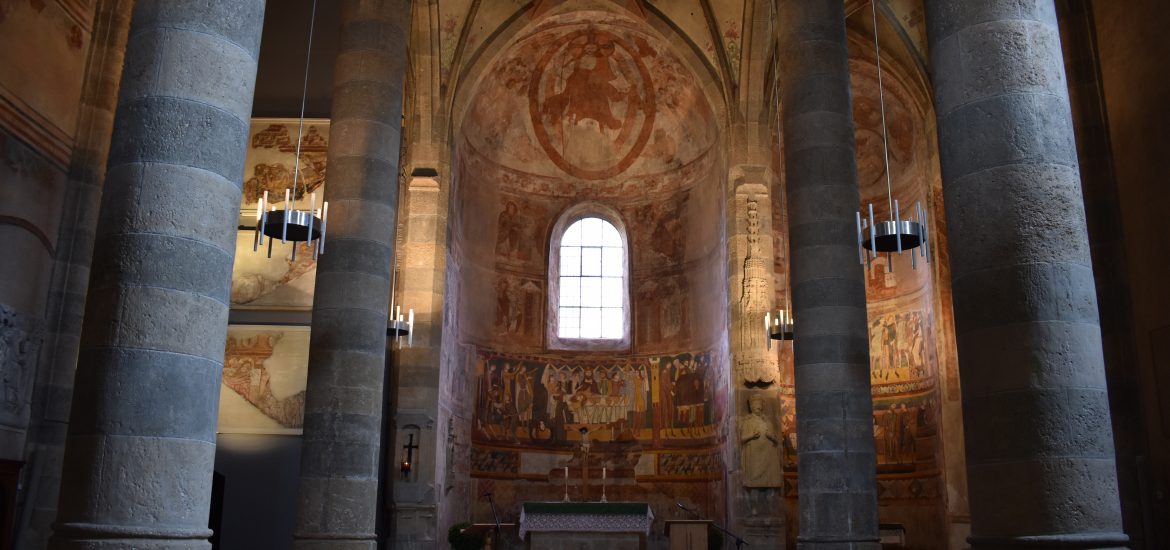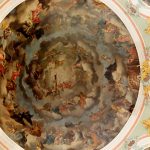Finally I’ve set my feet on the extreme north-east side of Switzerland. From the monastery St. Johann in Müstair, it takes only 10 mins by foot to cross the border to Italy.
Located in the village of Müstair in the lower Val Müstair valley, this monastery has been here for more than 1200 years and since 1983, it has been designated as a UNESCO World Heritage Site, sharing the honor with wonderful places such as the historic centre of Florence, Cologne Cathedral, the Tower of London and so on.
What surprises me most is that here is not merely a historic site, but a living convent for the nuns, which means nine Benedictine nuns are actually still living here. They live according to the ageless rule of “ora et labora et lege” (prayer, work and spiritual reading). The Benedictine motto has shaped the life in this convent for more than 1200 years and the morning prayers start at 5:30 and the final prayers start at 19:30. The nuns follow a clearly structured 14-hour routine every day and as a visitor, you are welcome to look into the spiritual life of the them.
At the beginning, I was a bit surprised to see the nuns doing their work in the church and the garden, but after I’ve come to notice that they are actually living here, this convent seems more lively to me than before. I was thinking, don’t they feel bored living here in a village, living a life so restricted? There are so many tourists visiting here, disturbing their usual life, and are they not annoyed? From the smile of all the nuns, I believe we, the visitors or the museum officers or the guides, are merely outsiders to them. What a peaceful mind they must possess to ignore all the influences of us, the “intruders”. I saw the nuns cleaning the church, lighting the candles, picking herbs in the garden, communicating with the visitors. All so peaceful and satisfied. How I wish I possessed such a state of mind, so that nothing trivial would make my heart grieve.
In general, as you can see from the site plan at the entrance, the buildings or sites you can or should visit are the church, the planta tower with the museum and the gift shop (together with the tourist office). You can enter the church free of charge but to enter the museum and the planta tower, you need to buy tickets at the tourist office first and then enter through the door at the back door inside the church by ringing the tourist office again to show that you have the tickets.

Opening hours:
Convent church and museum
May-October: 9:00-17:00
November-April: 10:00-12:00 and 13:30-16:30.
On Sundays and public holidays: 13:30-17:00.
Admission to the museum:
Adult: 12 CHF
Students and Apprentices: 8 CHF
School children: 6 CHF
If you have more questions about the opening hours or admission prices please feel free to contact me directly and I’ll try my best to help you solve your problems.
The first place you should stop by is the tourist office/The “Butia” shop. This is where you can buy tickets to the museum and ask about guided tours or other relevant info. Here is also the gift shop, in which items of craftwork made by the nuns or local products are sold.
Convent Church
The highlight of this convent is of course the convent church. The church dates back to the 8th century and has serves as the parish church of Müstair for 500 years.
Shortly before 800 the monastery church was decorated with a fresco cycle which illustrates the message of salvation in the form of an unbroken mural painting which extends round all of the walls. This unique treasure elevates Müstair to UNESCO world heritage rank.



The convent church contains priceless features, including the unique Carolingian and Romanesque frescos, the statue of Charlemagne and a late Gothic vaulted ceiling and nun’s gallery. The information I provide below are from the brochure you can obtain after you buy the museum ticket. I hope it gives you an insight of what you can expect from the convent church.
Around 800 the interior of the church was painted completely. One must imagine it as a simple hall with plain walls, windows high up and a flat ceiling. The pillars, the vault and the gallery were not added until 1492. Themes from the old and New Testament are portrayed in a continuous frieze in the nave. The series begins in the south east above the vault, and tells, in clockwise direction, The story of King David. In the three registers below, scenes from the life of Christ unravel: The first row shows Christ’s childhood, the second is a portrayal of his deeds and healings, followed by the Passion finally. On the wall sector above the middle apse, directly above the High Altar, where the Resurrection is celebrated at Mass, there is a portrayal of the Ascension. The panelled ceiling was presumably also painted. The Return of Christ and the Last judgement are to be seen on the west wall. The life and death of the patron saint of the convent, John the Baptist, is portrayed in the middle apse.The north apse is dedicated to the protomartyr St. Stephen.

Legend has it that after the coronation, Charlemagne was caught in a snowstorm while crossing the Umbrail Pass but managed to escape. In order to thank god for his escape, he is said to have founded the Convent of St. John. Nowadays, Charlemagne can still be seen in the convent church as the oldest monumental stucco statue.
With the statue of Charlemagne we return to the founder of the Mustair convent. The original is in a prominent position in the convent church between the middle and the south apse underneath a late Gothic baldachin from 1488. It clearly demonstrates the reverence for Charlemagne in Mustair in the Middle Ages. As the donor, Charlemagne probably originally carried a model of a church on his arm. This is how he is portrayed in a convent inventory from the year 1394. The arms, orb and sceptre are younger additions which, as historical photographs show, could be exchanged at will. The legs of local stone were made at the same time as the baldachin and the late Gothic church vaulting. The original parts of the figure are made of stucco. Charlemagne is wearing a decorated circlet crown, a belted tunic which reaches to his knees and, over this, an open riding cloak with pearl trimmings which is held together at the right shoulder by a fibula in the shape of a rosette. Seven different coats of paint could be identified on the statue. Our image of the mediaeval period is founded on knowledge, but there are also many gaps and a lot of speculation. This is reflected by the controversy surrounding the dating of the statue. The majority of researchers think it was made after his canonization in 1165, others speak out in support of an earlier dating in the Carolingian period. Meanwhile however, a date of origin in the 11th century has also been taken into consideration.
Planta Tower and the Museum
You can visit the church for free but if you wanna visit the planta tower and the museum you will have to but a ticket and enter from the door located at the back inside the church. Built in the 10th century, this defensive residential tower is the oldest of its kind.





In the planta tower and the museum you’ll be able to witness how the nuns and the priests lived for hundreds of years. Here you will see the cloister (ground floor), the herb garden, the Planta Tower (It was designed for living and defensive purposes and is thus one of the oldest fortified towers in Europe), the cellar (where you can see very rare window glasses from the time of Charlemagne in different shapes and colors), the refectory (where you can visit the dining hall and see the regal-one of the rare, small one-register organs), the dormitory (where you can see one of the most important pieces of mediaeval sculptures from around 1250), the Hohenbalken room, the cells (including the exhibitions such as sculptures, wax objects, decorated boxes etc.), the kitchen and the nun’s room, the winter choir, and the north annex of the church.
Thanks to the preservation, restoration, maintenance, and research work, you are even able to walk on the stairs which are already 500 years old. I strongly recommend people who are interested in archaeology, religion, or those who simply wanna know how the nuns or priests have been living since 1200 years ago, to visit this ancient but lively, mysterious but holly, famous but peaceful convent.
Parc Naziunal Svizzer
Admittedly, it takes quite some time to arrive at the convent. It takes more than 3 hours either by train or by car but the last forth of the journey is actually rather beautiful because you need to go through the Parc Naziunal Svizzer either by post bus or car if you drive by yourself. I actually enjoyed the whole journey as I’ve mentioned before, almost all the train routes in Switzerland are usually accompanied by mountains and lakes and it’s always pleasant to spend time on the way. The only thing I didn’t like was that I needed to change 3 times and it was a bit of fuss. However, the convent is in deed located at the extreme north-east side of Switzerland, I guess it is necessary to go through all the trouble to visit such a holy place.




Of course, in the nation park you can do hiking, cycling, swimming or skiing. Even though it takes quite sone time on the way, it’s easy to make the whole trip in one day. I suggest around 2 hours for the convent and if you get up early, you can of course spend some additional time doing some sports in the national park.
Want a spiritual escape from your busy life? Kloster St. Johann Müstair is your destination.





















































[…] I “met” him before. After thinking about it, I realized that I saw his stucco statue in St. John Monastery in Müstair, which is also a UNESCO World Heritage site. I also remembered that he is the emperor Charles the […]